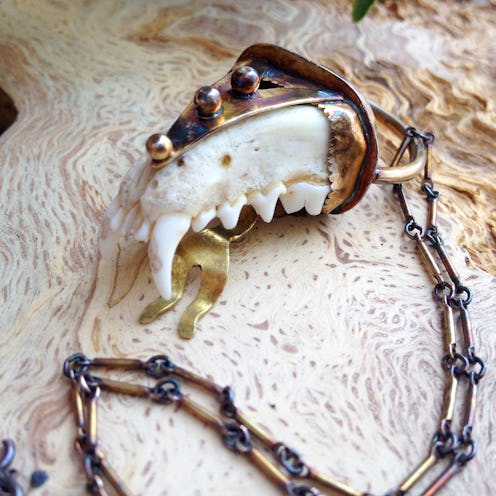
From a very young age the idea of eating parts of an animal was incredibly strange to me. My parents made several half-hearted attempts to get me to eat meat and I, already a spooky child, told them that I couldn't eat the meat because I could feel their dead souls inside my body. Over 20 years later, my vegetarianism now has a lot to do with the cruelty to animals of many corporations in the industry and the toll it takes on the environment; I try to avoid purchasing first-hand leather and somehow, I've organically been able to remove most animal products from my life — with the exception of taxidermy jewelry.
My obsession with bone-processing and taxidermy occurred only a few years ago while living in Oregon. My friend Morgaine Faye quickly became one of my favorite jewelry designers as I watched her casually take a dead bird and put it in her freezer. After I stared at her in disbelief, she took me up to her studio and showed me a world of death and metals. Morgaine has been processing bones for sculptures and jewelry for over 10 years. Originally from Santa Cruz, she's lucky to come from a family in-tuned with nature and the preservation of life. Her work is ethical and breathtaking, only purchasing animal parts when completely necessary and ensuring that those parts are cruelty-free.
Elk Tooth Necklace by Morgaine Faye (cruelty-free)
One of the more logical reasons of my vegetarianism has to do with the waste the meat industry produces. Morgaine and bone processors like her are committed to preserving the life of an animal and making sure no parts go to waste. They most often find animal parts from roadkill or friends who have sadly nailed a squirrel on their bicycle. Now living in Portland, Morgaine makes a very interesting point when we sat down to Skype and catch up about her work "Animals die everywhere, you don't have to live in the wilderness to process your own bones, cruelty free." This is a true story, and Morgaine often cleans her parts by burying them in the ground and letting the bugs do the dirty work.
Recently, bone processing in jewelry has gotten more and more popular. And why not? The witchy woman vibe is cool again, and the spirit of life in a pendant or a necklace is moving and astounding. Since it's becoming trendy it's important to note the pioneers that have been processing bones and performing taxidermy long before Rihanna wore a shark-tooth necklace.
Jana Miller is well-known in the community and has been performing taxidermy and bone processing and for over 35 years. Miller's work first caught my eye when I saw her human teeth series with molars set in intricate silver settings, but it was her "Token From The Heart" series that stole my heart.
Miller, like many in her field, grew up with a love and attachment to science and nature. "99% of my bone/taxidermy supplies I find dead and process myself. Even the insects," she told me. "Ethical sources are very important to me. I can't stress this enough. My art is not about glorifying death but rather honoring and celebrating life. I would much rather see any of the animals, insects, plants used in my art alive. I never have nor ever will harm or kill an animal, insect or plant for my bone collection or art."
Currently located in Gainesville, FL, Miller runs BoneLust studios where she sells and makes costume ordered taxidermy and jewelry. Salvaging animal parts is made easier because she has turned her property into an animal-friendly eco-system; hunters may dump deceased animals and roadkill is easy to come by.
Raccoon Vertebrae Necklace by BoneLust Studios
Of course, both artists are only processing animals that are legal to use in the United States. This is another important factor to keep in mind before blindly purchasing jewelry that incorporates a life once lived. It can be incredibly exciting to find a deer tooth necklace from a mainstream seller at a low price, but guess what? Most sellers that are ethically processing their bones are relatively affordable. Bonus tip: You can't get costume orders buying your bones from a large corporation for an inexpensive price.
Interested in getting some bad-ass jewelry made by eco-friendly, ethical sources? Check out these artists and Nature Punk's tumblr for some awesome ideas, products, and information on taxidermy and bone processing.
Images: Kristin Collins Jackson; Morgaine Faye; BoneLust Studios